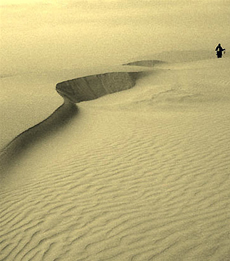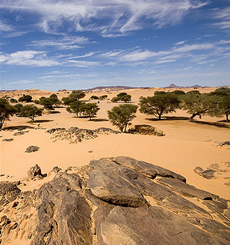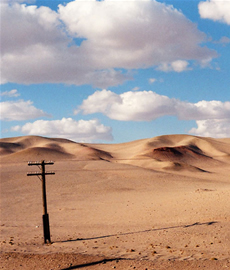Agriculture
Regions characterized by 10 inches or less of precipitation per year as considered deserts. Plants in desert biomes are typically specialized to endure the harsh conditions found there.
Deserts are regions, or biomes, too dry to support grasslands or forest vegetation but with enough moisture to allow specially adapted plants to live. In deserts, hot days alternate with cold nights.
Ninety percent of incoming solar radiation reaches the ground during the day, and 90 percent of that is radiated back out into space at night, the result of the absence of clouds, low humidity, and sparse vegetation.
The surface of the ground in desert areas is devoid of a continuous layer of plant litter and is usually rocky or sandy. Nutrient cycling in deserts is tight, with phosphorus and nitrogen typically in short supply.
How Deserts Form
Most large landmasses have interior desert regions. Air masses blown inland from coastal areas lose their moisture before reaching the interior. Examples include the Gobi Desert in Mongolia and parts of the Sahara Desert in Africa.
Another factor in the formation of deserts is the rain-shadow effect. If moisture-laden air masses bump up against a mountain range, the air mass is deflected upward.
As the air mass rises, it cools, and moisture precipitates as rain or snow on the windward side of the mountain range. As the air mass passes over the mountain range, it begins to descend. Because it lost most of its moisture on the windward side, the air mass is dry.
As it descends, the air heats up, creating drier conditions on the lee side of the mountain range. Sometimes these differences in moisture are so pronounced that different plant communities grow on the windward and leeward sides.
Latitude can also influence desert formation. Most deserts lie between 15 and 35 degrees north or south latitude. At the equator, the sun?s rays hit the earth straight on. Moist equatorial air, warmed by intense heat from the sun, rises.
As this air rises, it cools and loses its moisture, which falls as rain; this is why it usually rains every day in the equatorial rain forests. The Coriolis force causes the air masses to veer off, to the north in the Northern Hemisphere and to the south in the Southern Hemisphere.
The now-dry air begins to descend and warm, reaching the ground between 15 and 35 degrees north and south latitude, creating the belt of deserts circling the globe between these latitudes.
Deserts can also form along coastlines next to cold-water ocean currents, which chill the air above them, decreasing their moisture content. Offshore winds blow the air above cold ocean waters back out to sea.
In deserts, rain is infrequent, creating great hardships for the native plants and animals. The main source of moisture for the plants and animals of coastal deserts is fog.
Desert Vegetation
Many typical desert perennial plants, such as members of the Cactaceae (the cactus family), have thick, fleshy stems or leaves with heavy cuticles, sunken stomata (pores), and spiny defenses against browsing animals.
The spines also trap a layer of air around the plant, retarding moisture loss. Desert plants, many of which photosynthesize using C4 or CAM(crassulean acid metabolism), live spaced out from other plants. Many desert plants are tall and thin, to minimize the surface area exposed to the strongest light.
For example, the entire stem of the Saguaro cactus is exposed to sunlight in the early morning and late afternoon; at noon, only the tops of the stems receive full sun. These traits allow the plants to cope with heat stress and competition for water and avoid damage from herbivores (plant-eating animals).
Where the mixture of heat and water stress is less severe, perennial bushes of the Chenopodiaceae (goosefoot family) or Asteraceae (sunflower family) form clumps of vegetation surrounded by bare ground. Numerous annuals, called ephemerals, can grow prolifically, if only briefly, following rainfall.
Unrelated plant families from different desert areas of the world show similar adaptations to desert conditions. This has resulted from a process called convergent evolution.
Types of Deserts
Deserts are not all alike. Hot deserts are found in lower latitudes, and cold deserts are found at higher latitudes. North America contains four different deserts, which are usually defined by their characteristic vegetation, which ecologists call indicator species.
In Mexico?s Chihuahuan Desert, lechuguilla (Agave lechuguilla) is the indicator species of the Chihuahuan Desert. Fibers from lechuguilla can be made into nets, baskets, mats, ropes, and sandals. Its stems yield a soap substitute, and its pulp has been used as a spot remover.
Certain compounds in lechuguilla are poisonous and were once used as arrows and fish poisons. Two of the most common plants in the Chihuahuan Desert are creosote bush (Larrea divaricata) and soaptree yucca (Yucca elata). Cacti in the Chihuahuan are numerous and diverse, especially the prickly pears and chollas.
The Joshua tree (Yucca brevifolia), is the indicator species of the Mojave Desert in Southern California. Nearly one-fourth of all the Mojave Desert plants are endemics, including the Joshua tree, Parry saltbush, Mojave sage, and woolly bur sage.
The Great Basin Desert, situated between the Sierra Nevada and the Rocky Mountains, is a cold desert, with fewer plant species than other North American deserts. Great Basin Desert plants are small to medium-size shrubs, usually sagebrushes or saltbushes.
The indicator species of the Great Basin is big sagebrush (Artemisia tridentata). Other common plants are little leaf horse brush and Mormon tea. The major cactus species is the Plains prickly pear.
In the Sonoran Desert in Mexico, California, and Arizona, plants come in more shapes and sizes than in the other North American deserts, especially in the Cactaceae. The indicator species of the Sonoran Desert is the saguaro cactus (Carnegiea gigantecus).
The Sahara Desert of northern Africa is the world?s largest, at 3.5 million square miles. The Northern Hemisphere also contains the Arabian, Indian, and Iranian deserts and the Eurasian deserts: the Takla Makan, Turkestan, and Gobi. Deserts in the Southern Hemisphere include the Australian, Kalahari, Namib, Atacama-Peruvian (the world?s driest), and the Patagonian.
Environmental Considerations
Desert ecosystems are subject to disruption by human activities. Urban and suburban sprawl paves over desert land and destroys habitat for plants and animals, some of which are endemic to specific deserts.
Farmers and metropolitan-area builders can tap into critical desert water supplies, changing the hydrology of desert regions. Off-road vehicles can destroy plant and animal life and leave tracks that may last for decades.
- African Flora
African Flora With few exceptions, Africa?s flora (vegetation) is tropical or subtropical. This is primarily because none of the African continent extends far from the equator, and there are only a few high-elevation regions that support more temperate...
- Types Of Biomes
Types of Biomes The major recognizable life zones of the continents are divided into biomes, characterized by their plant communities. Temperature, precipitation, soil, and length of day affect the survival and distribution of biome species. Species diversity...
- Cacti And Succulents
Wild cacti Succulents are fleshy plants that store water in natural reservoirs such as stems or leaves. Cacti are a group of flowering plants; all cacti are succulents. The Cactaceae family includes about 1,650 to 3,500 species of cacti and succulents...
- Evolution: Convergent And Divergent
Evolution: Convergent and Divergent Some of the most dramatic examples of natural selection are the result of adaptation in response to stressful climatic conditions. Such selection may cause unrelated species to resemble one another in appearance and...
- South American Flora
South American FloraSouth America is the most diverse continent in terms of flora, primarily because of its location and geography. South America?s floristic diversity is increased by its high mountains, especially the Andes Mountains, which extend from...
Agriculture
Deserts
 |
| Desert |
Deserts are regions, or biomes, too dry to support grasslands or forest vegetation but with enough moisture to allow specially adapted plants to live. In deserts, hot days alternate with cold nights.
Ninety percent of incoming solar radiation reaches the ground during the day, and 90 percent of that is radiated back out into space at night, the result of the absence of clouds, low humidity, and sparse vegetation.
The surface of the ground in desert areas is devoid of a continuous layer of plant litter and is usually rocky or sandy. Nutrient cycling in deserts is tight, with phosphorus and nitrogen typically in short supply.
How Deserts Form
Most large landmasses have interior desert regions. Air masses blown inland from coastal areas lose their moisture before reaching the interior. Examples include the Gobi Desert in Mongolia and parts of the Sahara Desert in Africa.
Another factor in the formation of deserts is the rain-shadow effect. If moisture-laden air masses bump up against a mountain range, the air mass is deflected upward.
As the air mass rises, it cools, and moisture precipitates as rain or snow on the windward side of the mountain range. As the air mass passes over the mountain range, it begins to descend. Because it lost most of its moisture on the windward side, the air mass is dry.
 |
| White desert - Egypt |
As it descends, the air heats up, creating drier conditions on the lee side of the mountain range. Sometimes these differences in moisture are so pronounced that different plant communities grow on the windward and leeward sides.
Latitude can also influence desert formation. Most deserts lie between 15 and 35 degrees north or south latitude. At the equator, the sun?s rays hit the earth straight on. Moist equatorial air, warmed by intense heat from the sun, rises.
As this air rises, it cools and loses its moisture, which falls as rain; this is why it usually rains every day in the equatorial rain forests. The Coriolis force causes the air masses to veer off, to the north in the Northern Hemisphere and to the south in the Southern Hemisphere.
The now-dry air begins to descend and warm, reaching the ground between 15 and 35 degrees north and south latitude, creating the belt of deserts circling the globe between these latitudes.
Deserts can also form along coastlines next to cold-water ocean currents, which chill the air above them, decreasing their moisture content. Offshore winds blow the air above cold ocean waters back out to sea.
In deserts, rain is infrequent, creating great hardships for the native plants and animals. The main source of moisture for the plants and animals of coastal deserts is fog.
Desert Vegetation
 |
| Desert Vegetation |
The spines also trap a layer of air around the plant, retarding moisture loss. Desert plants, many of which photosynthesize using C4 or CAM(crassulean acid metabolism), live spaced out from other plants. Many desert plants are tall and thin, to minimize the surface area exposed to the strongest light.
For example, the entire stem of the Saguaro cactus is exposed to sunlight in the early morning and late afternoon; at noon, only the tops of the stems receive full sun. These traits allow the plants to cope with heat stress and competition for water and avoid damage from herbivores (plant-eating animals).
Where the mixture of heat and water stress is less severe, perennial bushes of the Chenopodiaceae (goosefoot family) or Asteraceae (sunflower family) form clumps of vegetation surrounded by bare ground. Numerous annuals, called ephemerals, can grow prolifically, if only briefly, following rainfall.
Unrelated plant families from different desert areas of the world show similar adaptations to desert conditions. This has resulted from a process called convergent evolution.
Types of Deserts
 |
| Types of Deserts |
In Mexico?s Chihuahuan Desert, lechuguilla (Agave lechuguilla) is the indicator species of the Chihuahuan Desert. Fibers from lechuguilla can be made into nets, baskets, mats, ropes, and sandals. Its stems yield a soap substitute, and its pulp has been used as a spot remover.
Certain compounds in lechuguilla are poisonous and were once used as arrows and fish poisons. Two of the most common plants in the Chihuahuan Desert are creosote bush (Larrea divaricata) and soaptree yucca (Yucca elata). Cacti in the Chihuahuan are numerous and diverse, especially the prickly pears and chollas.
The Joshua tree (Yucca brevifolia), is the indicator species of the Mojave Desert in Southern California. Nearly one-fourth of all the Mojave Desert plants are endemics, including the Joshua tree, Parry saltbush, Mojave sage, and woolly bur sage.
The Great Basin Desert, situated between the Sierra Nevada and the Rocky Mountains, is a cold desert, with fewer plant species than other North American deserts. Great Basin Desert plants are small to medium-size shrubs, usually sagebrushes or saltbushes.
The indicator species of the Great Basin is big sagebrush (Artemisia tridentata). Other common plants are little leaf horse brush and Mormon tea. The major cactus species is the Plains prickly pear.
 |
| The Sahara Desert |
The Sahara Desert of northern Africa is the world?s largest, at 3.5 million square miles. The Northern Hemisphere also contains the Arabian, Indian, and Iranian deserts and the Eurasian deserts: the Takla Makan, Turkestan, and Gobi. Deserts in the Southern Hemisphere include the Australian, Kalahari, Namib, Atacama-Peruvian (the world?s driest), and the Patagonian.
Environmental Considerations
Desert ecosystems are subject to disruption by human activities. Urban and suburban sprawl paves over desert land and destroys habitat for plants and animals, some of which are endemic to specific deserts.
Farmers and metropolitan-area builders can tap into critical desert water supplies, changing the hydrology of desert regions. Off-road vehicles can destroy plant and animal life and leave tracks that may last for decades.
- African Flora
African Flora With few exceptions, Africa?s flora (vegetation) is tropical or subtropical. This is primarily because none of the African continent extends far from the equator, and there are only a few high-elevation regions that support more temperate...
- Types Of Biomes
Types of Biomes The major recognizable life zones of the continents are divided into biomes, characterized by their plant communities. Temperature, precipitation, soil, and length of day affect the survival and distribution of biome species. Species diversity...
- Cacti And Succulents
Wild cacti Succulents are fleshy plants that store water in natural reservoirs such as stems or leaves. Cacti are a group of flowering plants; all cacti are succulents. The Cactaceae family includes about 1,650 to 3,500 species of cacti and succulents...
- Evolution: Convergent And Divergent
Evolution: Convergent and Divergent Some of the most dramatic examples of natural selection are the result of adaptation in response to stressful climatic conditions. Such selection may cause unrelated species to resemble one another in appearance and...
- South American Flora
South American FloraSouth America is the most diverse continent in terms of flora, primarily because of its location and geography. South America?s floristic diversity is increased by its high mountains, especially the Andes Mountains, which extend from...
